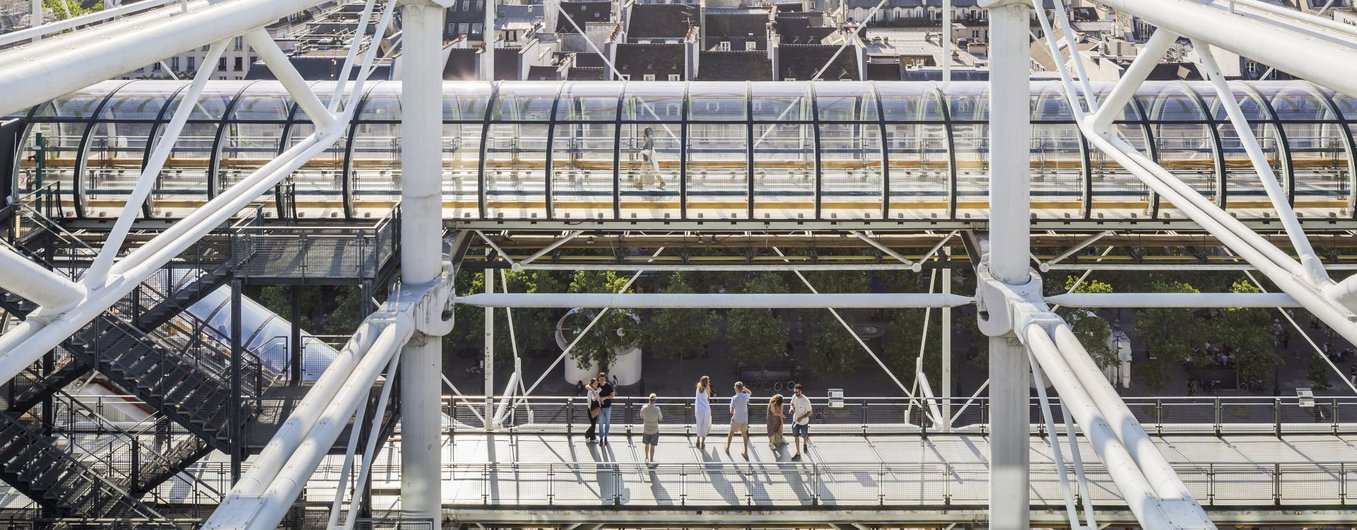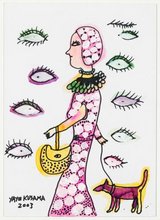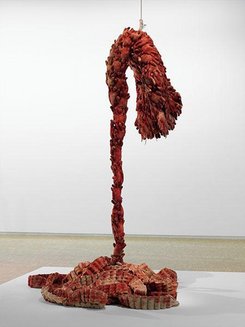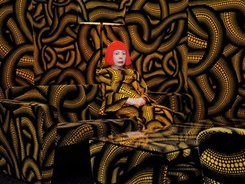Artist/personality
Yayoi Kusama
Plasticien

Yayoi Kusama
Plasticien
Nationalité japonaise
Birth: 1929, Matsumoto (Japon)
Place(s) of residence and work : Tokyo (Japon)
© Yayoi Kusama
Biography
Born in 1929 in Japan in a rural environment, and as she says, in a toxic family, Yayoi Kusama has created an atypical and radical body of work, always addressing the viewer’s body and trying to transmit her own hallucinatory visions. Affirming that "painting was the only way to keep myself alive" and exploring media as varied as painting, poetry, performance and monumental installations, the Centre Pompidou devoted a huge retrospective to her in 2012. This exhibition contributed to the late revival of this obsessional body of work, bearing crucial liberatory, critical and feminist aspects.
Yayoi Kusama has often recounted a particular childhood memory: one day, she saw the pattern of red flowers from the family tablecloth extend to the ceiling, walls and all over the room, even to her own arms. This early trauma, which led to a hospital stay, left her with the visceral fear of seeing herself self-obliterated. This concept of self-obliteration became the common theme of her works, her sole resort against anxiety and the only possible solution to her "compulsion to realise in visible form the repetitive image inside of [her]". As early as 10, she started to draw these visions, but her interest in art was impeded by her parents and more generally by a cultural environment that did not allow women to be artists. She studied art in Kyoto, then went to Tokyo in the 1950s, where she discovered contemporary Western art. Frustrated by the traditional teaching she received in Japan and increasingly isolated, she emigrated to New York - an exile which unleashed a rush of life and anger in her.
In New York, she discovered abstract painting, as testified by her first paintings, the Infinity Nets, a series in large immersive format. Then, from 1962 onwards, she used objects found on the sidewalk that she covered in phallic shapes made from fabric, as with the work My Flower Bed (1962), in which the artist liked to curl up. During her 15 years in New York, Yayoi Kusama traversed and shook up all the avant-garde movements: Pop Art, Action Painting, Body Art, and more. In 1966, a pivotal year, Yayoi Kusama designed her first environments, in which she often appeared naked. In 1969, she organised a protest / orgy against the Vietnam War in the garden of the Museum of Modern Art of New York, with a group of young naked people covered in coloured polka dots. Her critics said she was obsessed with celebrity, while in her native Japan, people deemed her a seeker of scandal. But what Kusama was blowing apart, by intentionally using tools to garner publicity, was the cage of moralism and taboos imposed upon women. In 1965, she created the Infinity Mirror Room (1965), in which she combined mirrors on the walls and the phallic growths covered in polka dots that had become her signature, in an enclosed room where the viewer loses the notion of time and space.
Despite her overflowing energy, she had difficulties finding her place in New York and decided to return to Japan in 1973. Following a series of painful events, in 1977 she checked herself into a psychiatric institution, where she continues to work devotedly. From her earliest drawings through to her recent monumental installations - like her breathtaking Fireflies on the Water (2002, Whitney Museum of American Art, New York) -, Yayoi Kusama, now the most famous female Japanese visual artist, has always placed her hallucinations and her childhood at the heart of her work.




